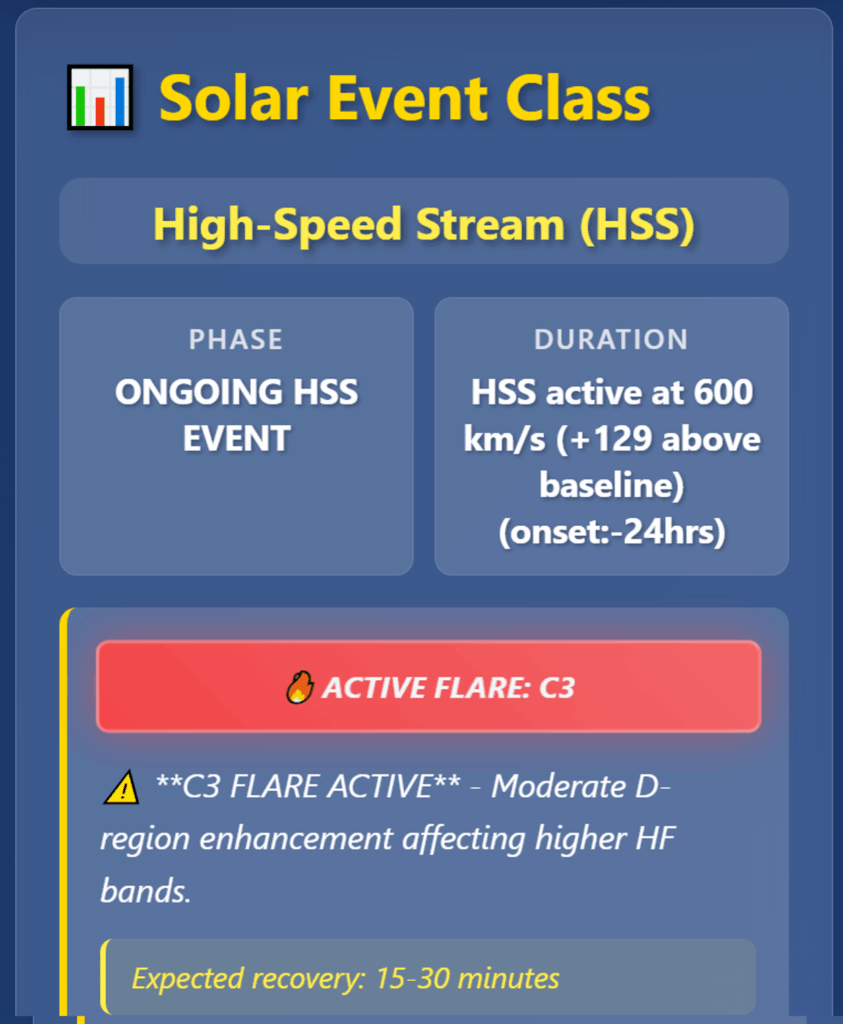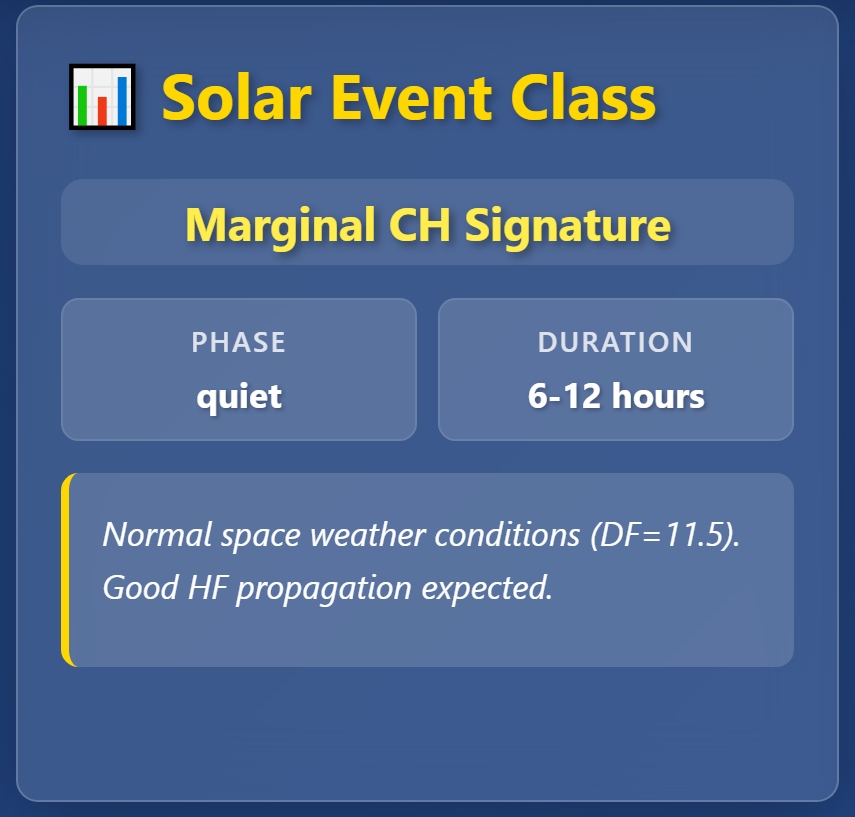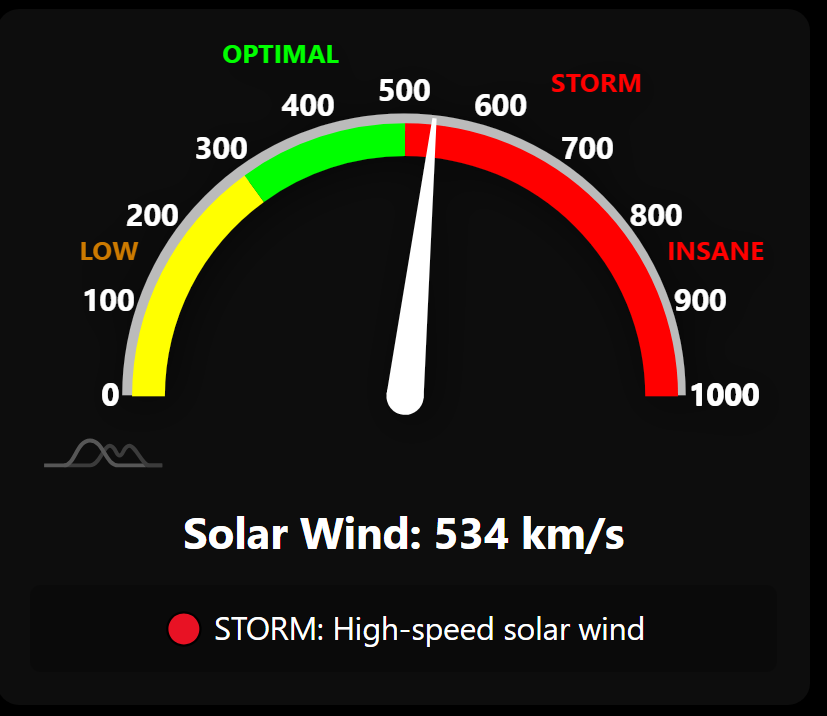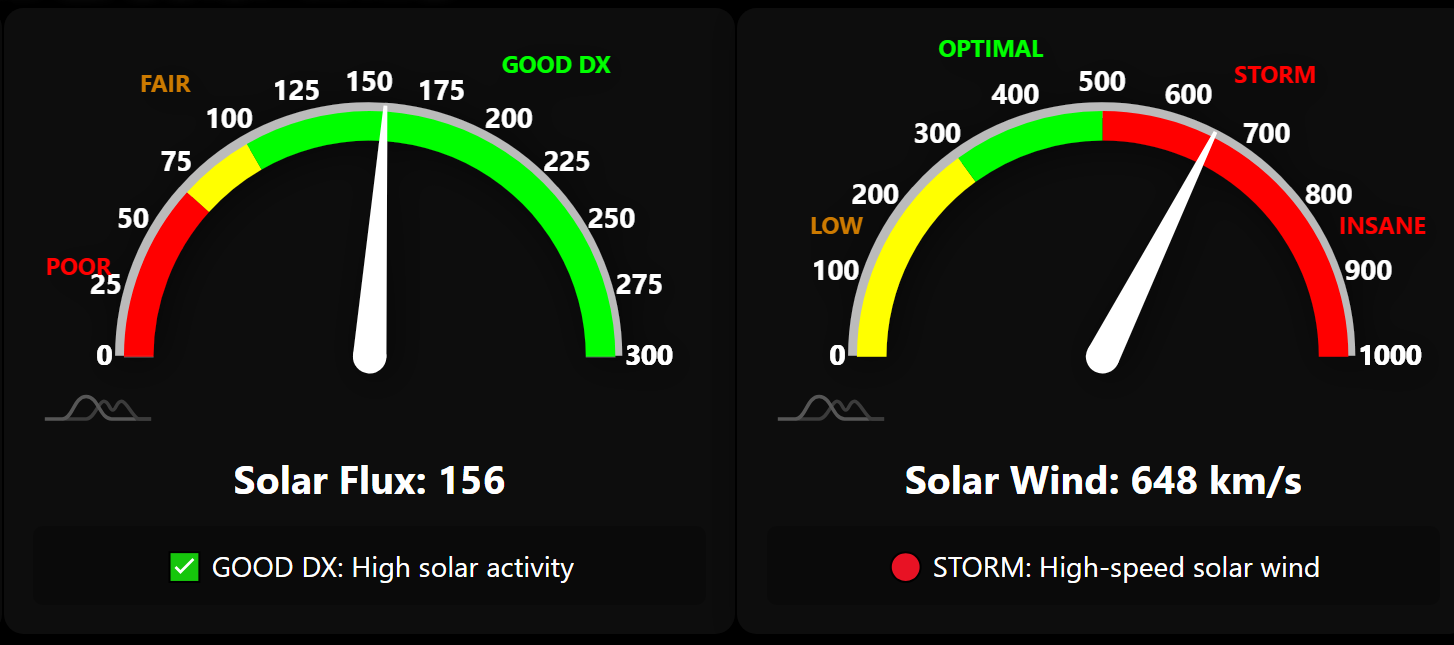Why this single parameter drives more amateur radio propagation changes than any other space weather variable
When most amateur radio operators check space weather, they look at the big three: K-index, solar flux, and maybe X-ray activity. They’re missing the most important variable of all. Solar wind speed – measured in kilometers per second – determines whether your next operating session will be excellent, marginal, or a complete washout.
Here’s what most operators don’t understand: Solar wind speed isn’t just another space weather parameter. It’s the primary engine that drives geomagnetic coupling – the process that creates or destroys your HF propagation paths.
The Physics: Why Speed Matters More Than Anything Else
Solar wind is the constant stream of charged particles flowing from the sun at speeds ranging from a gentle 300 km/s to a screaming 800+ km/s. When this plasma hits Earth’s magnetic field, the speed determines how much energy gets transferred into our magnetosphere.
The Critical Relationship
Energy Transfer = Solar Wind Speed² × Density × Efficiency
Notice that speed is squared in the energy equation. This means doubling the solar wind speed quadruples the energy impact on Earth’s magnetic field. A jump from 400 km/s to 800 km/s isn’t twice as bad – it’s sixteen times more disruptive.
This is why SolarCdx.com’s correlation engine treats solar wind speed as one of the primary drivers in calculating the Disturbance Factor. Every other parameter is important, but solar wind speed sets the foundation for everything else.
The Threshold Effect
Traditional space weather monitoring treats solar wind speed as a linear scale. That’s completely wrong. Solar wind speed has distinct threshold effects that create dramatically different propagation environments:
- <350 km/s: Below solar wind “escape velocity” – minimal geomagnetic coupling
- 350-450 km/s: Normal conditions – standard geomagnetic response
- 450-550 km/s: Enhanced coupling begins – first signs of propagation impact
- 550-650 km/s: Major coupling – significant HF band effects
- 650+ km/s: Extreme coupling – potential for severe disruption
Check SolarCdx.com’s real-time solar wind speed display – when you see speeds climbing above 450 km/s, start planning for band changes even if other indices still look quiet.
High-Speed Streams: The Multi-Day Events That Rule Amateur Radio
The most important space weather events for amateur radio aren’t solar flares – they’re High-Speed Streams (HSS) from coronal holes. These sustained periods of elevated solar wind speed create the recurring disturbances that affect contest weekends, DXpeditions, and regular operations.
HSS Event Characteristics

Duration: 2-7 days of elevated solar wind speed
Pattern: Recurring every 27 days (solar rotation period)
Speed Profile: Gradual rise to 500-700 km/s, then slow decline
Geomagnetic Impact: Repeated minor-to-moderate storms
Example HSS Event from SolarCdx.com data:
- Day 1: Solar wind rises from 380 km/s to 520 km/s
- Day 2: Sustained 550-600 km/s with recurring southward Bz periods
- Day 3: Peak speeds 650+ km/s, multiple geomagnetic disturbances
- Day 4-5: Gradual decline to 450 km/s
- Day 6-7: Return to background 350-400 km/s levels
Tactical intelligence: Once you identify an HSS event, you can predict 3-7 days of variable conditions with specific timing for disturbance and quiet periods.
The HSS Advantage: Predictable Patterns
Unlike random solar flares, HSS events follow predictable patterns that smart operators exploit:
Morning Hours (06-12 UTC): Often quiet periods during HSS events
Afternoon Hours (12-18 UTC): Peak disturbance likelihood
Evening Hours (18-00 UTC): Secondary quiet periods possible
Night Hours (00-06 UTC): Variable, depends on Bz orientation
SolarCdx.com’s HSS tracking system identifies these patterns and provides tactical timing recommendations based on current solar wind speed trends.
The Speed-Density Correlation: Advanced Pattern Recognition
Experienced space weather analysts don’t just watch solar wind speed – they watch speed-density correlations that reveal the source and likely behavior of solar wind streams.
Coronal Hole Signatures
High speed + Low density: Classic coronal hole stream
- Speed: 500-700 km/s
- Density: <5 particles/cm³
- Duration: 3-7 days
- Amateur radio impact: Recurring moderate disturbances, good recovery periods
Check SolarCdx.com’s current parameters display – when you see speeds >500 km/s with density <3 p/cm³, you’re in a coronal hole stream with predictable patterns.
CME Signatures
High speed + High density: Coronal Mass Ejection impact
- Speed: 400-800+ km/s
- Density: >10 particles/cm³
- Duration: 6-24 hours
- Amateur radio impact: Intense but brief disruption, rapid recovery
Quiet Conditions
Low speed + Normal density: Background solar wind
- Speed: <400 km/s
- Density: 3-8 p/cm³
- Duration: Days to weeks
- Amateur radio impact: Optimal propagation, all bands stable
Real-Time Tactical Applications
Contest Strategy Based on Solar Wind Speed
Pre-contest planning (48 hours before):
- Speed <400 km/s, stable: Plan normal high-band strategy
- Speed >500 km/s or rising: Prepare for lower band focus
- HSS event in progress: Plan around predictable disturbance cycles
Real-time contest decisions:
- Speed rising rapidly (>50 km/s per hour): Switch to lower bands immediately
- Speed declining after HSS peak: Prepare to move up in frequency
- Speed oscillating around 500 km/s: Monitor closely, be ready to adapt
Example from actual contest data: During ARRL DX 2024, solar wind speed rose from 420 km/s to 680 km/s over 18 hours. Operators monitoring SolarCdx.com’s speed tracking switched to 40m six hours before the K-index reflected the disturbance, gaining significant advantage over competitors still trying 20m.
DX Operations: Timing and Path Selection
Path reliability based on solar wind speed:
- <450 km/s: All paths stable, including marginal trans-polar routes
- 450-550 km/s: Polar paths degrading, mid-latitude paths stable
- 550+ km/s: Focus on short-path propagation only
Timing optimization:
- Rising solar wind speed: Work DX aggressively before conditions degrade
- Peak HSS conditions: Wait for brief quiet periods (check SolarCdx.com’s trend analysis)
- Declining speed: Excellent DX opportunities as conditions improve
Technical Operations: Digital Modes and Weak Signal Work
Solar wind speed thresholds for different modes:
- FT8/FT4 weak signal: Reliable up to 600 km/s solar wind
- CW/SSB marginal paths: Degraded above 500 km/s
- EME and microwave: Enhanced scatter possible during HSS events
The Correlation Engine Advantage: Speed + Context
SolarCdx.com’s correlation engine doesn’t just show you solar wind speed – it shows you speed in context with all other parameters:
Enhanced Coupling Detection
When the correlation engine detects:
- Solar wind >600 km/s + Bz strongly southward: “Enhanced Coupling” multiplier applied
- Tactical result: Higher Disturbance Factor than speed alone would indicate
- Operator benefit: Earlier warning of severe conditions
Isolated Speed Events
When the correlation engine detects:
- Solar wind >500 km/s + Bz northward + Low density: “Isolated HSS” classification
- Tactical result: Moderate impact despite high speed
- Operator benefit: Confidence to continue higher band operations
Recovery Predictions
SolarCdx.com’s speed trend analysis provides:
- Rate of solar wind decline in km/s per hour
- Predicted return to baseline timing
- Band-specific recovery estimates based on speed thresholds
Example: “Solar wind declining at 15 km/s per hour, baseline conditions (<400 km/s) expected in 8 hours, 20m recovery predicted in 4 hours.”
Advanced Techniques: Speed Duration Analysis
Sophisticated amateur radio operators track solar wind speed duration, not just current values:
Sustained Elevation Tracking
- Speed >500 km/s for <6 hours: Minor impact, quick recovery
- Speed >500 km/s for 6-24 hours: Moderate impact, plan around disturbances
- Speed >500 km/s for >24 hours: Major HSS event, multi-day planning required
SolarCdx.com tracks sustained elevation automatically and adjusts Disturbance Factor calculations based on duration effects.
Historical Pattern Recognition
Expert operators use SolarCdx.com’s data to identify recurring HSS events:
- Same coronal hole produces similar speed profiles every 27 days
- Seasonal variations affect HSS intensity and duration
- Solar cycle position influences background solar wind characteristics
The Bottom Line: Speed Rules Everything
Solar wind speed is the master variable that determines whether your amateur radio operations succeed or fail. While other operators focus on lagging indicators like K-index, smart operators watch real-time solar wind speed and plan accordingly.
Every 50 km/s increase in solar wind speed represents a significant change in geomagnetic coupling efficiency. The difference between 400 km/s and 600 km/s isn’t subtle – it’s the difference between excellent propagation and challenging conditions.
Master solar wind speed monitoring with SolarCdx.com’s real-time correlation engine. Watch speed trends, understand HSS patterns, and use speed-based tactical intelligence to optimize your amateur radio operations.
Because in space weather, speed isn’t just important – it’s everything.
Master solar wind speed intelligence at SolarCdx.com. Monitor real-time solar wind speed trends, HSS event tracking, speed-density correlations, and get tactical recommendations based on current and predicted solar wind conditions. Transform the hidden variable into your competitive advantage.
73,
Glenn Gianino


